Cambodia The Way toward the World HeritageMarch 2011
A report on the border dispute between Cambodia and Thailand

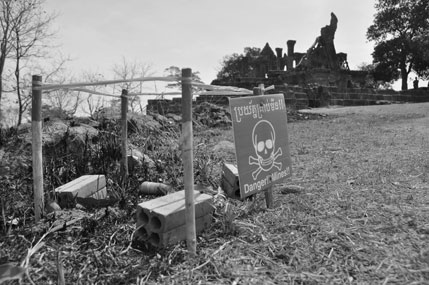
A world heritage site the Preah Vihear Temple lies on the top of the Dangrek Mountains which forms the border between Cambodia and Thailand. In early February Cambodian and Thai troops fought hard over the temple, which caused casualties, produced domestic refugees and damaged the World Heritage site. Cluster bombs, which are being banned all over the world, were used for the fight, and things have reached the worst possible pass.
The Preah Vihear Temple is a Hindu temple built in eleventh century. Being recognized as a masterpiece showing creative ability of humans, the temple was inscribed on the list of the World Heritage sites in July 2008. It is the second heritage in Cambodia listed as a cultural World Heritage after Anchor Watt. Both of Cambodia and Thailand had stationed a few border guards, but since the value of the area as a tourist attraction has been increased, the both countries have deployed military troops as many as about 4,000 strong in all and tension there has mounted.
There was no choice.

Living in his second house in Preah Vihear province, a colonel of the Cambodian army Mr.Chan Darun(60) has been watching the border every day. He explained how the fight had started in February in English, which he had learned in Canada. “The Thai army is trying to build a straight road to Wat Keo Sikha Kiri Svara in Cambodia with heavy industrial machines. We have warned them not to cross the buffer line which was decided by both Cambodian and Thai armies. But Thai troops didn’t keep the agreement and made inroads on our territory, pointing their guns at Cambodian troops. We have to guard the border and protect our country. So, there was no choice for us. I have corroborative pictures.” He recorded the whole scene on video tape, including the Thai soldiers entering with guns and the gunfight from start to finish. The pictures were repeatedly televised in the U.S.A.
According to the Cambodian and the Thai governments, six people were killed and 70 were wounded on the Cambodian side, and two were killed and 34 were wounded on the Thai side.
Cambodian citizens think …
First, I asked the Cambodian citizens about their opinions on this border dispute. Ms. Kahn Sophen(36), who runs a restaurant in Anlong Veng, one of the hubs of border trade with Thailand, said, “The Preah Vihear Temple belongs to Cambodia. Thailand is taking it by force. I’m very angry at Thailand.” A biketaxi driver Mr. Sokkar(29), who drives in Kompong Thom, from which National Road 12 leading to the Preah Vihear Temple started, said, “I feel ‘pain’ because we have believed the Preah Vihear Temple is ours, but Thailand is invading it.” A student of Royal University of Law and Economics in the Cambodian capital Phnom Penh Mr. Chuong Pichet(20) said, “The Preah Vihear Temple has never been in a good state of preservation. Worse still, it was damaged by the battle. I’m very sad.”
The moved borderline

Geographically, there is a cliff 500 meters high on the south of the Preah Vihea Temple on the Cambodian side, while there is a gentle slope on the north of the temple on the Thai side. It is obvious that this temple was built on the premise that visitors would enter the temple from the north. The then Khmer Empire put the area around present-day Lopburi in Thailand under its rule, so that there was no borderline there. The Khmer Empire, however, had declined since the 15th century, invaded from the north by Thailand and from the south by Vietnam. At present the cobbled entrance path to the temple is in the Thai territory and the steep flight of stone-steps from the gate to the temple is in Cambodian territory, so the borderline lies within the precincts. While visitors can go to the temple easily by car from the Thai side, from the Cambodian side they have to make a considerable detour around the valley.
Cambodia became independent from France in 1953, but Thailand has tried to push the borderline into the Cambodian side. So in 1959 Cambodia asked the International Court of Justice in Hague to confirm that the Preah Vihear Temple belongs to Cambodia. Then, in 1962 the Court gave decision that the temple should belong to Cambodia. Thailand, however, didn’t approve the French-made map which was exhibited for the judgment and redrew a map on a scale of 1 to 50,000 with American technical help. The Thai map differed from the French map in the location of the border, and came out an overlapping area of 4.6 square kilometers (between the light green line and the red line on the above map). Thailand claims that the area has not been demarcated.
The road to the World Heritage Site
I visited the site, which was eight hour’s drive from Phnom Penh. When I looked up from an about 40-degree angle of elevation on National Road 12, I saw a man-made structure on the ridge of the Dangrek Mountains. It was GopuraⅠwhich lies in the innermost of the Preah Vihear Temple to the Cambodian side. We drove past right under the temple and turned to the north. We changed the car into a four-wheeled pick-up truck at an open space on the foot of the mountain, where there was a first-aid station and trenches. The road beyond here was so bad and inclined so steeply that only tall and powerful vehicles could climb the slope. I heard an excavator excavating a mountain and a bulldozer roaring in a cloud of sand. The Cambodian government was hurrying to complete the roadway to the Preah Vihear Temple. As of March 2011, the roadway was opened to traffic, but it had only one lane and it was unpaved; besides there was no crash barrier on the edge of the cliff. The roadway was right in the middle of the construction to widen it.
This roadway is within the disputed area of 4.6 square kilometers. Thailand insists that the dominium of the area is pending. While Cambodia claims that the area is her territory because it lies on her side of the border. The reason why the two countries run counter to each other is simply that the location of the border on the map Thailand consults is different from that on the map Cambodia does. Naturally they condemn each other for invasion of the territory. If they use force, the dispute may develop into a battle. Thailand wants the visitors from the outside countries to the newly inscribed World Heritage site to go from the Thai side, even though it lies in Cambodian territory, so that Thailand is trying not to let Cambodia build an easy access road. Such Thai government’s intensions are obvious.
It opened to tourists once
After the Pol Pot group that entrenched themselves in a border area disappeared, that is, the Cambodian civil war practically came to end, and land mines in the precincts were removed, the Cambodian government opened the Preah Vihear Temple to tourists in 1988. At the end of 2001 foul water from the precincts flowed into a Thai river and the relations between the two countries deteriorated, so the temple was closed for one and a half years. Except for that time, the temple has attracted tourists from Japan and Western countries. But almost all of the tourists have visited it from the Thai side. The Thai government sent its army at the head, Thai monks and farmers into the disputed area to rule it practically and tried to make it an accomplished fact. However, in 2007 when the Cambodian government applied for inscription of the temple on the World Heritage list, the government tried to expel Thais from that area which Cambodia claims for her possession, which created conflicts with Thailand. Since then the Preah Vihear Temple has been closed at least from the Thai side.
However, Preah Vihear province is a depopulated area, where the density of population is 12 persons to a square kilometer. As the geographical environment near the temple is severe, there is no Cambodian village. Only civilians who live there are monks of a Buddhist temple Wat Kao Sikha Kiri Svara standing to the west side of the Preah Vihear Temple. But there are Cambodian makeshift camps set up here and there behind rocks or piled-up sandbags, so there are many soldiers and their families. Since there is no arable land, they live on distributed rice, precooked-Chinese noodles and canned food.
The World Heritage site was damaged.
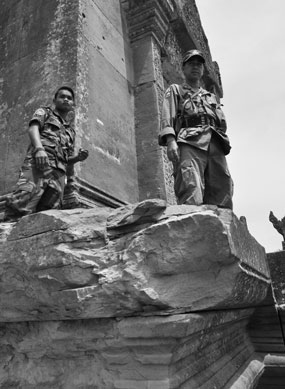
The roadway still under construction ascends to the top by way of Wat Kao Sikha Kiri Svara and ends at an open space on the right side of the front entrance to the Preah Vihear Temple as you face it, that is, on the west side of Gopura V, the fifth gateway. The Cambodian government may be planning to make the space a parking lot for visitors. At the northern end of the open space, there is a place to hoist the national flag, and the Cambodian flag with a design of Angkor Wat is fluttering in the wind. On a peak several hundred meters northeast from there, Thai observation platform and the Thai national flag on a flagpole can be seen. Also the open space overlooks a brand-new paved road built by Thailand. On the road two white lines were drawn; on its shoulder telegraph poles stand regularly in a row; and a thick wire is laid.
The battle fought here in February of this year lasted for four days. In the Preah Vihear Temple I saw some deep bullet holes on the wall and some parts of pillars and handrails damaged by flown-off shell splinters. The marks were conspicuous. Thailand claimed that the Cambodian army attacked the Thai army, using the temple as its fort, so they fired back. However, the stone-built structure that had withstood all weathers for 1,000 years was damaged in a moment. A cleaner of the temple said, “Everyone screamed. My knees knocked together. I don’t know whether it is surely safe now or not, but it’s getting better than before.” I saw red signs with skull and crossbones standing here and there. Next to the signs there used to be land mines, but now there are unexploded shells of trench mortars stuck into the ground or explosives of a cluster bomb lying about. Now that the troops of both sides are confronting in a touch-and-go situation, there is no tourist in the temple but there are spiders spinning their webs on the carvings in relief and cicadas continuously chirring in chorus.
It was exploded instantly when it was put on a desk, and five men were killed or wounded.
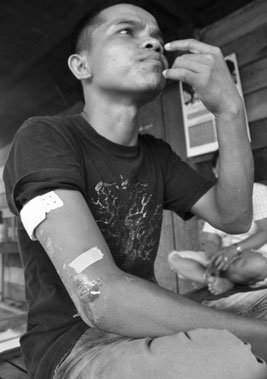
Although three weeks have passed since the battle, pools of blood on the stone floor of the ruins haven’t dried up yet. I visited a wounded police officer Mr. Vith Sovanarath(24), who was staying at home in Preah Vihear City to recuperate. He said, “A battle was fought on February 4th for six hours from 3:00 p.m. against Thai troops. Just after the battle ended, we went to the Preah Vihear Temple to examine the site with our chief from the police station at the foot of the mountain. In the precinct we found a strange weapon and took it back to the police station to show a specialist. The moment we put it on the desk, it blew up.” When he was drawing a picture of the bomb to show me, I saw a scar and lymph fluid oozing out from the scar in his arm. But the young police officer courageously said that he would return soon to work to secure public order. “I was brought to a hospital in Preah Vihear City but four others were brought to a hospital in Siem Reap. Two were dead and three were wounded.” What the officers had brought in was a bomblet of a cluster bomb.
A bomblet is easily exploded by a vibration or a shock, so it mustn’t be touched carelessly. But bomblets are left in the precincts without disposal. A bomblet is smaller than a tennis ball but bigger than a ping-pong ball. Some of the bomblets are two-tone of silver and yellow and the others are solid silver. Some are shaped like a water bottle with a string. They look like a toy, or a part of a car or a motorcycle. If you saw such a bomblet on the field where you can see only grass and stones, even you would be impelled to pick it up, let alone children.
A new problem-the problem of how to remove cluster bombs
I visited the Cambodian Mine Action Centre (CMAC) Demining Unit in Preah Vihear. Within its premises there was a hole about five meters deep, surrounded with sand bags, and next to the hole a red sign with skull and crossbones was put up. At the bottom of the hole unexploded shells of 155 mm howitzers were laid. I heard the shell was 1,105 mm long. The deputy chief Mr. Chhim Sovany(51) said, “This is a kind of cluster bomb which contains many bomblets. Shells of this kind were found after the bombardment by the Thai army. Now we are collecting them for examination.” When a cluster bomb is dropped from the air, its cartridge opens in mid-air and disperses its bomblets. But in this kind of cluster bomb the bomblets contained in the rear half of the cartridge disperse after landing.
Preah Vihear province is one of the areas where the Pol Pot group holed up to the last. While the CMAC is clearing landmines laid during the civil war, a new problem has arisen- cluster bombs which would kill or wound people for decades in the same way as landmines. After the 2007 Oslo Declaration endorsed by 46 countries, the Convention on Cluster Munitions that prohibits the use, production, transfer and stocking of cluster munitions was adopted by many countries, but Thailand didn’t join it.
Shells hit the place 20 kilometers away from the border.
Shells of Thai 155mm howitzers hit Cambodian villages and the national road 20 kilometers away from the border in Preah Vihear province. I saw a big hole two kilometers in diameter on the asphalt national road passing through Svay Chrun Village. Away from the hole there was a motorbike-repair shop beside the national road. On the tin wall of the shop there were many sharp holes pierced by shell splinters. The shop owner Mr. Bun Thuen(51) said, “I was in a trench behind the house at that time. And then another shell dropped near the trench. My children fled to a place of safety beforehand. So luckily no one was injured.” But it is most probable that there are bomblets of a cluster bomb and unexploded shells lying around here, so they want CMAC to dispose of those explosives as soon as possible.
In an orchard located 100 meter away from the spot on the national road that a shell hit, I could see Cambodian T59 tanks and a BM21 multiple rocket launcher. Heavy firearms have a range of over 20 kilometers, and the terrain near the border area is steep especially on the side of Cambodia, so the troops of both side seemed to fire from well short of the border. They bombarded at each other’s launching site, with the result that noncombatant civilians were embroiled in the battle.
Worry that the children might touch

On Cambodian side 2,956 families of about 10,000 people took refuge from the Thai bombardment in seven camps. Although nearly one month has passed since the battle, 65 families can’t return to their villages and have been forced to live in tents in a refugee camp. A refugee Ms. Chum Yen(32) came to this camp with three children and resumed a frugal business of selling watermelons which she had done at the market in her village. “Unless the situation calms down, we cannot go home. We are scared that our village may be bombarded again. Also we worry about cluster bombs. Since there is no one who takes care of my children while I go out for work, it worries me that my children might touch a cluster bomb.”
In this camp there is a deep well with a pump which is shared with the families living in a military base in the neighborhood. And also the refugees are provided with food and new tents. When there were many refugees in this camp, even a medical team was stationed at the medical office. Besides the number of the soldiers mobilized, I could see the Cambodian government wrestling with this boundary problem for the national prestige.
Bordering countries
About 70 kilometers away from the Preah Vihear Temple to the west on the border between Cambodia and Thailand is located Choam international border crossing in Anlong Veng district of Oddar Meanchey province. On the contrary to the tense atmosphere near the World Heritage site life goes on peacefully here. The local people are allowed to cross the border without a passport for shopping, peddling and going for work in a day. Of course, it is prohibited for them to stay for a long time in their opponent country and to go as far as Bangkok or Phnom Penh. For us Japanese whose country is not connected with any other country by land their sense is not easily comprehensible. Some Cambodian people live near the border in the Thai territory, and not a few Cambodian people living near the border can speak Thai language. At least in Southeast Asians’ general territory consciousness, it had mattered to them which government the inhabitants in the border area follow more than the location of the border. Now that interests in the temple have arisen by inscription on the World Heritage list, which fomented a dispute, it is required to make the undefined border clear.
I decided to cross the border at Choam and go back to the east, and then enter the Preah Vihear Temple from the Thai side. When I went into Thailand, I saw a wide well-maintained road and handsome houses by the roadside. I couldn’t help feeling the disparity in national power between the two countries. The area of Sisaket province in Thailand, which borders Cambodia, is a national park called the Khao Phra Wihan National Park. It is a tourist resort in peacetime, but now there is a Thai army’s check point at the entrance of the park and nobody can go close to it, including journalists.
Damage on the Thai side
The remains of exploded rocket-propelled grenades which the Cambodian army launched were stood against the sandbags at the check point. The several grenades hit the entrance office, the residence of the park caretaker and the lavatory for visitors, wreaking havoc on their roofs and rooms.
According to the Cambodian government report, the Thai army bombarded Cambodia for four days; from 3:10 p.m. to 5:30 p.m. on February 4th, from 6:20 a.m. to 7 a.m. on 5th, from 6:30 p.m. to 8:05 p.m. and 50 minutes from 11:20 p.m. on 6th, and from 7:30 a.m. to 8:25 a.m. on 7th. Although Cambodia claimed they just fought back, they seemed to have launched the rocket-propelled grenades intensively, with the result that much damage was done to the Thai side too.
A staff member of the national park Mr. Tawin Tichanah(44) said, pointing at the direction from which the rocket-propelled grenades had come, “On February 4th and 6th, when I was about to cook dinner, the bombardments started, so I ran into this shelter.” At the entrance of the tunnel-shaped concrete shelter sandbags were piled up. Inside the shelter a vinyl sheet was spread and a TV and an electric pot were put on the table. Theses shelters were built by the army, and the residents can wait bombardments to stop in the shelters, watching TV over a cup of hot coffee. The condition in a shelter also made me realize the disparity in national power between the two countries.
A Cambodian rocket-propelled grenade hit a school directly.
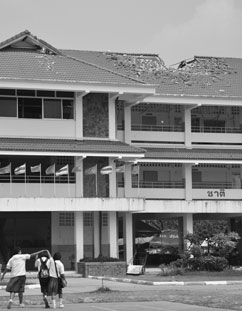
A Cambodian rocket-propelled grenade hit directly a junior high and high school in Ban Phum Saron village which was close to the border. It made a big hole in the roof of the three-story school and played havoc with the classroom. “When I was watching a game, the bombardment started. We got instructions to evacuate through the school public address system, so we entered the shelter,” said a seventh grader Mr. Sinappa(13). Luckily on that day, the athletic meet was being held and there was no one in the classrooms on the third floor, so that none of the 567 students, teachers and staff were killed or injured.
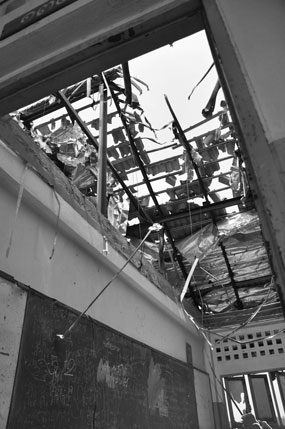
The students were taking lessons in tents pitched on the school grounds. One of the reasons for it was that some of the classrooms were unable to be used. But another 7th grader Ms. Endou(13) said, “We especially seventh graders study in tents close to the shelters so that we can evacuate immediately when we are bombarded again.” At the corner of the school grounds shelters of the same kind as those in the national park were lined up. According to a Cambodian high government official, a Cambodian reconnoitering party found out that there was a Thai artillery bombardment position near here, so they launched a counterattack, which caused this destruction. Civil facilities are hardly distinguishable from military facilities in battle, with the result that civilians are involved. “I wish the war would end soon. I’m scared,” Ms. Endou. said. A banner saying ‘NO WAR’ was strung up in the school. Messages of comfort and encouragement were sent in, which shows that Thai citizens all hate an armed clash between the governments.
A Thai civilian was also killed.
Thai casualties were relatively slight, because concrete shelters were made at strategic points in advance, and the Cambodian army didn’t use a cluster bomb. But yet a noncombatant farmer was killed. Mrs. Sossy(56) took me to the field behind her house and said, “My husband died here.” She pointed at the bottom of a trench. Around 6 p.m. on February 4th a rocket propelled grenade came into the depression one meter deep, and its splinter hit the farmer’s neck and he died. “I knew this place was dangerous. But I’ve never thought we would be under so fierce bombardment like this. I wish our government would make up with Cambodia soon and stop the war. We can’t work under these conditions,” she said emphatically.
At the main part of the village I heard metallic sounds of power tools here and there. The students of an engineering college in Sisaket province were voluntarily rebuilding houses that were partially or completely destroyed by the bombardment. Their teacher Mr. Worawithet(51) leading this volunteer group said proudly, “We are building seven houses. The expenses are all covered by the aid from civilians. It costs 500,000 baht a house.” They have finished setting up the framework of a steel-frame two-story house, and now they are roofing with colored tin. I heard that the border was three kilometers distant from here, but I didn’t see any modern house like this on the south side of the border. Again this shows vividly the disparity in economic power between Thailand and Cambodia.
Is the confusion of the Thai domestic administration a cause?
In 2007 United Nations Educational, Scientific and Cultural Organization (UNESCO) deferred the inscription of the Preah Vihear Temple, a Hindu temple built in the 11 century, on the World Heritage list on the ground that the temple ruins were located on the border and the only access to the temple was from Thailand, so that it was advisable that the application should be made jointly by Cambodia and Thailand. But Thai Foreign Minister Noppadon Pattama of the Samak administration gave support to Cambodia’s unilateral application in June 2008. And then the inscription of the Preah Vihear Temple on the World Heritage list was decided in July 2008.
In Thailand, however, regime change has often occurred in recent years and her foreign policy seems to lack consistency. Prime Minister Samak declared openly, “I am a representative of Thaksin.” He was once a leader of the People’s Power Party which had tenacious support from the Red Shirt group whose members were mainly formers and laborers. The party, showing the understanding of the neighbor’s position, had executed a soft-line policy. But the politicians and citizens of the anti-Thaksin Yellow Shirt group protested against the Cambodia’s unilateral application, and the Constitutional court decided that the sympathy without the National Assembly’s approval was unconstitutional; as a result, Foreign Minister Noppandon was forced to resign on July 10th. In any case, changing foreign policy for domestic reasons may make diplomatic relations worse and give rise to a dispute.
Curbside interviews in Thailand
As the border dispute with Cambodia has been reported widely by the media, everyone knows it in Thailand. But the citizens looked to be fed up with violence because the government has suppressed the red-shirts by force. It seemed to me that many citizens coolly looked at the government that was also using force to solve this matter. The first person whom I interviewed on the street was a veterinarian Ms. Kanikarh(35). “I think both countries have a misunderstanding about the ownership of the area. Each claims that the area is its own territory. Both of them are trying to make their claims known as rightful to their own people. The common peoples of Thailand and Cambodia are not in conflict; a Thai marries a Cambodian and a Cambodian marries a Thai, and both peoples do business with each other.” She views both governments at a distant. Ms. Saryon(50), who was selling Thai cuisin Som Tam, putting a steelyard on the sidewalk, said, “It’s a territorial problem. Each claims title to the land. Thailand should give the land to Cambodia, and the war would end.” She seemed to be sympathetic to Cambodia. With thick files of reference materials under his arm, Mr. Suriyaphon(24) on the master’s course in the Department of Eeconomics at Thammasat University said, “I think the politicians of each country are taking advantage of this border issue. Talks between the two countries of Thailand and Cambodia may go amiss, so an international conference with a reliable third country taking part should be held.” He made practical and sound remarks.
Prime Minister Hun Sen proposed a way out of the present difficulty.
Cambodia’s Prime Minister Hun Sen showed the way to the settlement of the dispute as follows. (1) Cambodia and Thailand should sign a cease-fire agreement with the countries of ASEAN present, (2) the troops of both sides should be ordered to stay put and the number of the soldiers should be reduced, (3) the both frontier commanders should discuss to ease tension, (4) the working group from ASEAN should be sent to the site to monitor the cease fire, and (5) the then map of the year 1962 should be interpreted by the International Court of Justice in Hague Netherlands. ASEAN agreed this plan, but it has been deadlocked because the key party Thailand opposed the article (4).
The Thai government has insisted on negotiations between the two countries, refusing Indonesian working group to monitor the cease fire and mediation by ASEAN, the U.N., or the U.S.A. If the negotiations were conducted with a third country taking part, not only with Cambodia whose national power is weak, Thailand might be put at a disadvantage, which the Thai government is afraid of, I presume. Is it the reason why the border near the Preah Vihear Temple doesn’t follow the watershed that the border line was drawn by France, Cambodia’s former suzerain, not by agreement between Cambodia and Thailand, I wonder?
Cambodia counts on the international public opinion.
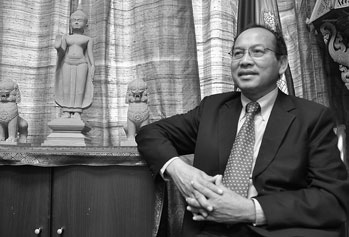
As the Cambodian government wants to explain Cambodia’s situation to the world, Government spokesman Phay Siphan did the courtesy of meeting a mere reporter like me. “The Thai army fired 416 shells at the Preah Vihear Temple and the surrounding area in February. Among the shells cluster bombs, the use of which was prohibited worldwide, were included. A bomblet will explode when it is touched, so there’s probability that people will be killed or injured by bomblets for decades to come. It is not too much to say that Thailand committed war crimes against mankind.” Projecting the well-organized materials for presentation onto a big monitor screen, he tried to justify Cambodia’s action in fluent English.
“Thailand wants to capture the 4.6 square km area from Cambodia, claiming that it belongs to Thailand, though the International Court of Justice decided on 1962 that the area should belong to Cambodia on the basis of the international map. Cambodia and Thailand both approved the same border on the same map at the meeting in 1925 and 1937. The International Court of Justice rejected the map which Thailand had drawn by herself before 1962 and employed the old map which had been used before.”
Cambodia has used the map which was drawn by the French authority in conformity with the 1904 French-Thai agreement and published in Paris in 1908. The map was drawn on a scale of 1 to 200,000 and the border line was by and large drawn along the watershed of Dangrek Mountains. However, in the part where the Preah Vihear Temple stands the border line was drawn on the north side of the watershed, with the result that the temple and a detour to the temple are in Cambodian territory. In consideration of the benefit to French-owned Cambodia, the border line in this part was intentionally moved, and on then map this part was enlarged to show it clearly.
A man of learning and experience views…

Associate professor Chawin Leenabanchong(52) in the Faculty of Economics at Thammasat University in Thailand said, “I think Cambodia has a misunderstanding about the decision of the International Court of Justice. The 1962 decision said that the Preah Vihear Temple belonged to Cambodia, but it didn’t refer to the border. At that time Cambodia was French territory, and Thailand and France made an agreement that the border should follow the watershed, but the border line near the Preah Vihear Temple didn’t match the watershed on the French-made map.” He explained logically like a scholar. He said that the map was attached to the application as a reference material to decide the ownership of the temple, but the validity of the map had not been questioned at the court, which brought about the today’s dispute.
Thailand, however, put the drawing of the map into the hands of France, though Thailand and France made an agreement that the border should follow the watershed. Moreover, although the Thai government confirmed that the border and the watershed didn’t match by measurement conducted in 1934, they didn’t protest to France. They may not have realized its significance. The Thai government had tacitly accepted the map until Cambodia applied for inscription of the temple on the World Heritage list recently. Chawin said, “We ordinary Thai people want to know why our government had accepted that map.” He expressed his discontent at the attitude of the past government. He analyzed this border dispute and said, “I think this border dispute was caused by letting Cambodia have the Preah Vihear Temple listed on the World Heritage list.” If that is the case, I figure it means Thailand admitted herself that she started the armed clash.
The border dispute seems to drag on
Thailand has developed economically in spite of repeated coups de’tat. Before 2005 five properties in Thailand were listed on the World Heritage list, including Historic City of Ayutthaya and Dong Phayayen-KaoYai Forest Complex. On the other hand, in Cambodia a civil war had lasted nearly for 30 years. Preah Vihear province and Oddar Meanchey province had been under the influence of the Pol Pot group even after being in the control by United Nations Transitional Authority. Until around 1998 when the guerrillas of the Pol Pot group got weak because of internal strife and Pol Pot’s death, the people of the Phnom Penh side couldn’t enter these areas except visiting pinpointed places by helicopter. So, especially these areas were behind in the development of farmland and roads. With inscription of the temple on the World Heritage list as a start, roads to Phnom Penh, the Cambodian capital, and to Siem Reap, where Angkor Wat is located, are going to be prepared in a hurry.
During this trip I had a chance to talk with a Thai journalist. He works as the news desk at a TV station, but his viewpoint is just like that of a reporter who works for a government-operated media under a one-party dictatorship. He didn’t seem to try to understand Cambodian historical background, conditions and claims objectively. He is assuming the same stance as the present government’s and rattles on their views. It seems to me that the news programs which he is in charge of add fuel to the hard-liners’ opinions and make it more difficult to settle the dispute, while the media and journalists of the third country mostly watch the dispute calmly, because the dispute was caused not by energy resources but by a cultural heritage that is not directly connected with the national interests of their own countries.
After I came back to Japan from this trip, a large-scale armed clash occurred again in April. Cambodia asked the International Court of Justice to confirm that the Preah Vihear Temple belongs to Cambodia. It seems as if this border dispute will be long drawn out, because a minor power Cambodia has a historically advantageous past, and international public opinion and the Red Shirts group in Thailand are showing their sympathy for Cambodia. The Cambodian government knows it and thinks inwardly that the border dispute doesn’t need to be settled down quickly. Their intention of using this dispute as a diplomatic card to contain Thailand for a while can be seen off and on.
